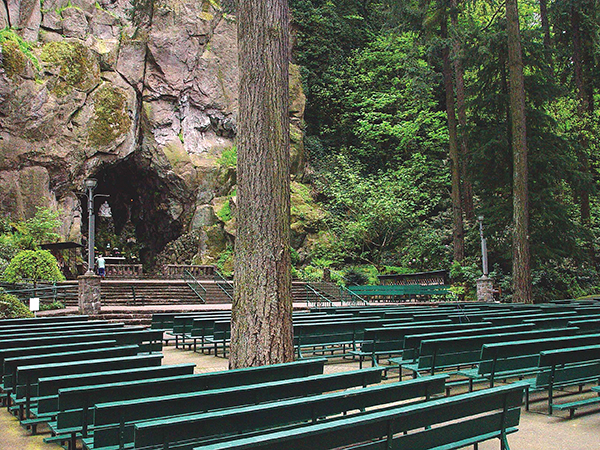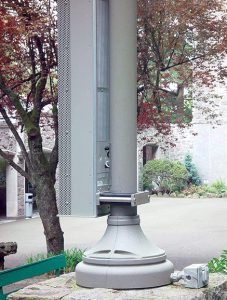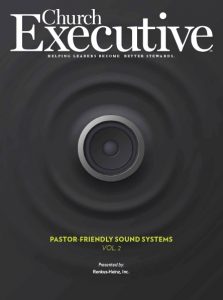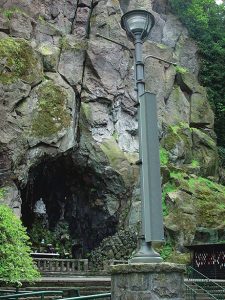
The Grotto — a stunning outdoor sanctuary in Portland — is a truly challenging audio environment. First and foremost, church leaders needed awe-inspiring audio to match the sanctuary’s surroundings. But, the system also had to be flexible, reliable, durable … and discrete. Here’s how they got everything on their wish list.
By Mike Lethby
 Known as “The Grotto” since its founding in 1924, The National Sanctuary of Our Sorrowful Mother in Portland, OR, is a rare “place of solitude, peach and prayer” in a bustling city. For nearly 100 years, this beloved Catholic Shrine and botanical garden — spanning an amazing 62 acres — has served as a source of spiritual respite for worshipers and visitors alike.
Known as “The Grotto” since its founding in 1924, The National Sanctuary of Our Sorrowful Mother in Portland, OR, is a rare “place of solitude, peach and prayer” in a bustling city. For nearly 100 years, this beloved Catholic Shrine and botanical garden — spanning an amazing 62 acres — has served as a source of spiritual respite for worshipers and visitors alike.
What makes it so unique is its conception and design as an outdoor cathedral; it marries religious significance with natural scenic beauty — dramatic rock formations, towering fir trees and lush gardens. Our Lady’s Grotto, the central attraction, was carved from solid basalt in the cliff wall in 1925. Above its natural rock altar is a white marble replica of Michelangelo’s Pieta.
With more than 100 religious sculptures and two glorious chapels, it’s no wonder that The Grotto draws more than 200,000 visitors per year, representing all faiths and countries. It’s one of the most beautiful Marian sanctuaries in North America, and perhaps the world.
A place of light and sound, The Grotto is home to the annual Festival of Lights during the Christmas season, and more than 140 choirs throughout the year.
 Wait … doesn’t it rain a lot there?
Wait … doesn’t it rain a lot there?
It does. In this sense, the Pacific Northwest’s reputation is well warranted. However, the months of May through October bring very little precipitation — and, not surprisingly, this is when The Grotto (for which the entire property is named) “comes into its own. It’s difficult to envision a lovelier site for Sunday Mass, a wedding or other religious celebration … and there are many, here, during those months.
But, it’s not all sunshine and roses; although gorgeous, The Grotto is a challenging environment in which to run a live sound system. The winter brings heavy rain and occasional freezing temperatures. And, the seating area slopes down and away from the actual grotto and the altar in front of it, making it difficult to ensure sound coverage.
And of course, the Friars are not experts in modern audio technology. Even so, their audio requirements can range from simple background music to elaborate services combining singers, musicians and the spoken word.
Fortunately, they and the staff can call upon the expertise of Design Sound Northwest (DSN), a local AV systems design and integration firm headed up by Craig Leppert, principal. Leppert was instrumental during The Grotto’s most recent construction phase, an endeavor which included a remodel of the outdoor worship space.
For this unique — and unusually challenging — audio environment, Leppert had the foresight to install extra conduits under the concrete and asphalt. These conduits run from the altar area in front of The Grotto to a small building that houses much of the electrical and audio infrastructure. By design, smartly, these elements are protected from the elements.
Ease of use was another priority for Leppert and the client. To create a simple, yet flexible, interface — one that’s easy to understand — he linked a wireless AMX NetLinx control panel with a Biamp AudiaFlex digital signal processor.

Hailing back to the need for flexibility, Leppert was able to set up three operating modes: Daily (read: low-level background music), Small Group, and Large Events. Each is selected, as needed, from the AMX panel. Normally, it sits on a desk inside the control room; however, Leppert and his team also installed a high-gain directional antenna so that musicians can take the panel outdoors to control input levels.
“We gave the end users a very basic, limited set of options,” he explains. “We programmed presets into the Audia with individual level and EQ settings for every channel, for quick and easy setup. The wireless AMX panel allows simple adjustments to be made on the fly, from any location, so the musicians are in control of their performance.”
For small services, the “Small Group” preset gives users access to four wireless microphones and allows them to control the CD player.
For the Large Events preset, DSN pulled a multicore snake through one of those spare conduits: it is terminated with a 60-pin LK disconnect in a waterproof box near the musician’s staging area. To set up for a large service, the staff simply picks the right preset and connects the remote mic snake, instantly giving them 16 wired mic channels, foldback monitors, four wireless mics and CD / Tape playback.
By design, the celebrants are well served by this system …
But what about the worshippers?
With thoughtful design, Leppert has them covered, too. One of DSN’s key objectives was to provide quality sound to an extremely wide, downward-sloping seating area (with the added challenge of residential neighbors across the street from the rear), all without compromising The Grotto’s unique fusion of natural and manmade beauty.
“We tried lots of different ideas,” he recalls. “My first thought was to hide some big directional speakers up in the trees, but there were too many practical issues.”
Indeed: Though portable speakers could do the job, as Leppert explains, there is no way to (a) fill the hole in the middle of the seating area, or (b) keep the sound from shooting over listeners’ heads. Not to mention portable speakers require a labor-intensive setup.
Plan B wasn’t a great fit, either: hanging compact loudspeakers from the arms of The Grotto’s light poles — as Leppert calls it, “the Disneyland approach.” The problem with this scenario was the large visual footprint. Avoiding this was very important to the client, particularly Executive Director Father Jack Topper.
So, Leppert and his team considered a third option. A digitally steered column could mount flush to the light pole, becoming almost invisible — or could it? Not so much, as Leppert and his team found out.
Even though the speakers could be removed and stored inside during the winter, they still needed protection from the unpredictable Portland weather in the other months.
“The first major manufacturer we considered told us we would need a separate fiberglass enclosure around the loudspeaker,” Leppert recalls. “That would have been too bulky and clumsy-looking.” Neither of those distractions would pass muster with Father Jack and the other leaders at The Grotto, who prioritize aesthetics.
Even so, DSN built a full-size mockup in the shop so The Grotto staff could assess the visual impact. “After having it mounted on the light pole only one day, Father Jack and the staff rejected it,” Leppert recalls. “They said it would be too intrusive.”
 Another year passes without the perfect solution
Another year passes without the perfect solution
During that time, the Grotto made do with a portable system. Then, Renkus-Heinz announced its Iconyx series of digitally steered arrays.
Importantly for the aesthetics-focused church staff, the modular Iconyx arrays could be made weather-resistant without expanding the aluminum enclosures. So, they weren’t bulky.
What’s more, each Iconyx module had an eight-channel, DSP-driven amplifier inside to accomplish the array steering.
For reliability, AC power was supplied via Furman power conditioners, with ground fault interruptors in line, just in case excessive moisture does appear in the electronics compartment.
Renkus-Heinz also brought years of color-matching experience to the table. As such, they were able to exactly match the existing light pole color. Still, a dummy installation was still a pre-requisite for final approval.
“We mounted a dummy enclosure on the pole for over a week,” Leppert says. “Father Jack told me that he walked right past that pole numerous times without noticing it.”
Although the client was satisfied, Leppert and his team spent a few more months researching and developing specialized stainless steel mounts with built-in security features and UDP inserts that fit the light poles tightly without marring the paint. The mounts are tamper-proof, but also so simple that grounds staff can remove the Iconyx enclosures in only 15 minutes for winter storage, and then re-install them just as easily once the rains take a break.
Next up: troubling acoustics
With the visual and mounting hurdles surmounted (beautifully), DSN turned to the acoustic problem at The Grotto. To optimize the coverage, Leppert and his team conducted a basic Enhanced Acoustic Simulator for Engineers (EASE) model.
“The wide, 140-degree horizontal pattern works well in this application, even though the two light poles are very far apart,” he explains. “With the digital steering, we can mount the arrays flush on the poles, yet aim the sound downward so it covers the seating area well without annoying the neighbors.”
Clearly, attention to detail is a guiding principle for Leppert and his team at DSN. Their thoughtful approach to delivering naturally beautiful sound at The Grotto — including the incorporation of aesthetically pleasing, yet durable and effective loudspeakers — is one of the main reasons he and his crew enjoy a long-standing relationship with leaders at this iconic outdoor sanctuary, as well as many other corporations, religious and educational institutions in the Northwest & Alaska.
Naturally beautiful sound: achieved.
Mike Lethby is director of ML Media Ltd. This article was prepared on behalf of Renkus-Heinz, Inc. Located in Southern California for more than 35 years, Renkus-Heinz is a manufacturer of high-end professional loudspeaker systems.


